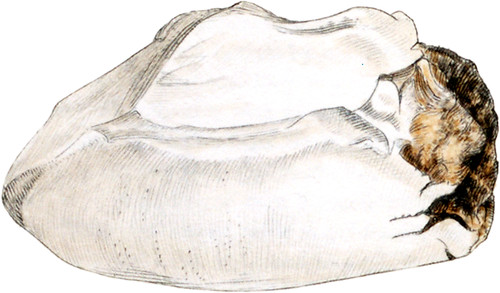 Enlarge
Enlarge
Exotic Mineralogy
Lenzinite
- Syn.
- Alumine Hydratée Silicifere. Léon Dufour in Journal de Phys. de Chim et d’Histoire Natur. 86, 251.
- Lenzinite. John, ibid. 86, 169.
The mineral before us has obtained the name of Lenzinite, although it be not quite identical with that so named by John. There are two varieties of Lenzinite deseribed by this celebrated chemist; one transparent, like semi-opal; the other Opaque and unctuous to the touch: they are both found at Kail, in the Eisel. Lelièvre describes, in the An Bales des Mines, vol. II, p. 473, a mamillated substance, which he compares to Hyalite, that was found by him many years ago, encrusting stones in a lead mine, on the mountain of l’Esquerre, on the left bank of the Oo, in the Pyrenees; when fresh collected it was wet and soft; but when dried it became brittle a ad hard enough to scratch Carbonate of Lime ; its analysis, as will be seen below, shews it to be somewhat similar to Lenzinite: Lelièvre named it Aluinine hydratee siliciicre. Mr. F. J. B. Menard seeing that memoir, recollected a tallow-like mineral, found in quarries of indurated Calcareous Marie, (Tuffau of the people of the country) near Mans, in the department of the Sarte; it occurred in nests and roundish pieces, about the size of nuts. He proposes to call it Wallerite, considering it different, although it contained the same ingredients as the mineral described by Lelièvre, and which he would call Lievrite, if that name were not adopted for another mineral (Silex Lievri, tab. 79.) Lastly, Mr. Leon Dufour found, in an alluvial deposit, the mineral now figured, at St. Sever, in the department of the Landes, about the beginning of 1818; it is in masses that are sometimes as large as one’s head: its texture is very fine and even, and soft enough to yield to the nail, which gives it a polish; when fresh broken it smells strongly of apples: in general it is opaque, but some parts are semi-transparent. It hardens when heated, but is not fusible ; in water it falls to pieces with a crackling noise. The following analyses shew the relationship of the substances above-mentioned; it is very probable that they are all casual productions, either deposited by water, containing the particles of decomposed Feldspar, or some other mineral suspended in it, or, perhaps, even the immediate result of the decomposition of some stone that once occupied their places in the rocks where they occur. Cimolite and Collyrite also appear to be analogous, and lead towards common Pipe Clay.
| Lenzinite | Alumine hydratée silicifere | ||||
| opaline. By John. | argilleuse. Ib. | From St. Sever. by Pelletier | From L’Esquerre. by Berthier. | From nr. Mans. By Vanquelin. | |
| Silex | 37.5 | 39 | 50 | 15.0 | 47 |
| Argilla | 37.5 | 35.5 | 22 | 44.5 | 21 |
| Water | 25 | 25.0 | 26 | 40.5 | 30 |
| Lime | a trace | 0.5 | 0 | 0. | 0 |
| Iron | 0. | a trace | 0 | 0. | 2 to 3 |
| 100.0 | 100.0 | 98 | 100.0 | 100. | |
| Collyrite by Klaproth. | Cimolite also by Klaproth. | |
|---|---|---|
| Argilla | 45 | 23 |
| Silex | 14 | 63 |
| Water | 42 | 12 |
| Iron | 1.25 | |
| 101 | 99.25 | |
I have been favoured with the Siliciferous subsulphate of Alumine by Dr. W. Henry, which he has described in Thompson’s Annals, v. II. p. 432: when fresh it resembles hogs’ lard, but must be considered as distinct from Lelièvre’s mineral above mentioned: it is a casual production from the decomposition of the Shale in a coal mine near Oldham.

